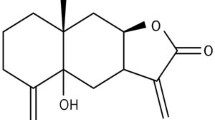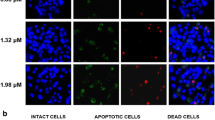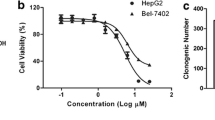Abstract
Liquiritin (LIQ), a major constituent of Glycyrrhiza Radix, exhibits various pharmacological activities. In this study, to explore the potential anti-cancer effects and its underlying molecular mechanisms of LIQ in hepatocellular carcinoma (HCC) cells. LIQ significantly decreased viability and induced apoptosis in HepG2 cells by decreasing mitochondrial membrane potential and regulating Bcl-2 family proteins, cytochrome c, cle-caspase-3, and cle-PARP. The cell cycle analysis and western blot analysis revealed that LIQ induced G2/M phase arrest through increased expression of p21 and decreased levels of p27, cyclin B, and CDK1/2. The flow cytometry and western blot analysis also suggested that LIQ promoted the accumulation of ROS in HepG2 cells and up-regulated the phosphorylation expression levels of p38 kinase, c-Jun N-terminal kinase (JNK), and inhibitor of NF-κB (IκB-α); the phosphorylation levels of extracellular signal-regulated kinase (ERK), protein kinase B (AKT), signal transducer activator of transcription 3 (STAT3), and nuclear factor kappa B (NF-κB) were down-regulated. However, these effects were reversed by N-acetyl-l-cysteine (NAC), MAPK, and AKT inhibitors. The findings demonstrated that LIQ induced cell cycle arrest and apoptosis via the ROS-mediated MAPK/AKT/NF-κB signaling pathway in HepG2 cells, and the LIQ may serve as a potential therapeutic agent for the treatment of human HCC.







Similar content being viewed by others
References
Belayachi L, Aceves-Luquero C, Merghoub N, de Mattos SF, Amzazi S, Villalonga P, Bakri Y (2017) Induction of cell cycle arrest and apoptosis by ormenis eriolepis a morrocan endemic plant in various human cancer cell lines. Afr J Tradit Complement Altern Med 14:356–373. https://doi.org/10.21010/ajtcam.v14i2.37
Bours V, Bentires-Alj M, Hellin AC, Viatour P, Robe P, Delhalle S, Benoit V, Merville MP (2000) Nuclear factor-kappa B, cancer, and apoptosis. Biochem Pharmacol 60:1085–1089
Chen H, Zhou L, Wu X, Li R, Wen J, Sha J, Wen X (2016) The PI3K/AKT pathway in the pathogenesis of prostate cancer. Front Biosci (Landmark Ed) 21:1084–1091
Chetram MA, Bethea DA, Odero-Marah VA, Don-Salu-Hewage AS, Jones KJ, Hinton CV (2013) ROS-mediated activation of AKT induces apoptosis via pVHL in prostate cancer cells. Mol Cell Biochem 376:63–71. https://doi.org/10.1007/s11010-012-1549-7
Cui YQ, Liu YJ, Zhang F (2018) The suppressive effects of Britannin (Bri) on human liver cancer through inducing apoptosis and autophagy via AMPK activation regulated by ROS. Biochem Biophys Res Commun 497:916–923. https://doi.org/10.1016/j.bbrc.2017.12.144
Eruslanov E, Kusmartsev S (2010) Identification of ROS using oxidized DCFDA and flow-cytometry. Methods Mol Biol 594:57–72. https://doi.org/10.1007/978-1-60761-411-1_4
Gierasch LM (2016) The Journal of Biological Chemistry: 2016 Onward. J Biol Chem 291(27):15406–15407. https://doi.org/10.1074/jbc.E116.000001
Goldar S, Khaniani MS, Derakhshan SM, Baradaran B (2015) Molecular mechanisms of apoptosis and roles in cancer development and treatment. Asian Pac J Cancer Prev 16:2129–2144
Gorrini C, Harris IS, Mak TW (2013) Modulation of oxidative stress as an anticancer strategy. Nat Rev Drug Discov 12(12):931–947. https://doi.org/10.1038/nrd4002
Hao W, Yuan X, Yu L, Gao C, Sun X, Wang D, Zheng Q (2015) Licochalcone A-induced human gastric cancer BGC-823 cells apoptosis by regulating ROS-mediated MAPKs and PI3K/AKT signaling pathways. Sci Rep 5:10336–10343. https://doi.org/10.1038/srep10336
He SH, Liu HG, Zhou YF, Yue QF (2017) Liquiritin (LT) exhibits suppressive effects against the growth of human cervical cancer cells through activating Caspase-3 in vitro and xenograft mice in vivo. Biomed Pharmacother 92:215–228. https://doi.org/10.1016/j.biopha.2017.05.026
Ke F, Wang Z, Song X, Ma Q, Hu Y, Jiang L, Zhang Y, Liu Y, Zhang Y, Gong W (2017) Cryptotanshinone induces cell cycle arrest and apoptosis through the JAK2/STAT3 and PI3K/Akt/NFκB pathways in cholangiocarcinoma cells. Drug Des Devel Ther 11:1753–1766. https://doi.org/10.2147/DDDT.S132488
Ku JM, Kim SR, Hong SH, Choi HS, Seo HS, Shin YC, Ko SG (2015) Cucurbitacin D induces cell cycle arrest and apoptosis by inhibiting STAT3 and NF-κB signaling in doxorubicin-resistant human breast carcinoma (MCF7/ADR) cells. Mol Cell Biochem 409:33–43. https://doi.org/10.1007/s11010-015-2509-9
Li XQ, Cai LM, Liu J, Ma YL, Kong YH, Li H, Jiang (2018) Liquiritin suppresses UVB-induced skin injury through prevention of inflammation, oxidative stress and apoptosis through the TLR4/MyD88/NF-κB and MAPK/caspase signaling pathways. Int J Mol Med 42:1445-1459. https://doi.org/10.3892/ijmm.2018.3720.
Lin MT, Lin CL, Lin TY, Cheng CW, Yang SF, Lin CL, Wu CC, Hsieh YH, Tsai JP (2016) Synergistic effect of fisetin combined with sorafenib in human cervical cancer HeLa cells through activation of death receptor-5 mediated caspase-8/caspase-3 and the mitochondria-dependent apoptotic pathway. Tumour Biol 37:6987–6996. https://doi.org/10.1007/s13277-015-4526-4
Liu CY, Chen KF, Chen PJ (2015) Treatment of liver cancer. Cold Spring Harb Perspect Med 5:a021535. https://doi.org/10.1101/cshperspect.a021535
Marzo I, Naval J (2008) Bcl-2 family members as molecular targets in cancer therapy. Biochem Pharmacol 76:939–946. https://doi.org/10.1016/j.bcp.2008.06.009
Ola MS, Nawaz M, Ahsan H (2011) Role of Bcl-2 family proteins and caspases in the regulation of apoptosis. Mol Cell Biochem 351:41–58. https://doi.org/10.1007/s11010-010-0709-x
Ozer Etik D, Suna N, Boyacioglu AS (2017) Management of hepatocellular carcinoma: prevention, surveillance, diagnosis, and staging. Exp Clin Transplant 15:31–35. https://doi.org/10.6002/ect.TOND16.L9
Palanivel K, Kanimozhi V, Kadalmani B, Akbarsha MA (2014) Verrucarin A induces apoptosis through ROS-mediated EGFR/MAPK/Akt signaling pathways in MDA-MB-231 breast cancer cells. J Cell Biochem 115:2022–2032. https://doi.org/10.1002/jcb.24874
Puthdee N, Seubwai W, Vaeteewoottacharn K, Boonmars T, Cha’on U, Phoomak C, Wongkham S (2017) Berberine induces cell cycle arrest in cholangiocarcinoma cell lines via inhibition of NF-κB and STAT3 pathways. Biol Pharm Bull 40:751–757. https://doi.org/10.1248/bpb.b16-00428
Rawlings JS, Rosler KM, Harrison DA (2004) The JAK/STAT signaling pathway. J Cell Sci 117:1281–1283. https://doi.org/10.1242/jcs.00963
Shao D, Ma J, Zhou C, Zhao JN, Li LL, Zhao TJ, Ai XL, Jiao P (2017) STAT3 down-regulation induces mitochondria-dependent G2/M cell cycle arrest and apoptosis in oesophageal carcinoma cells. Clin Exp Pharmacol Physiol 44:413–420. https://doi.org/10.1111/1440-1681.12708
Sun SY, Hail N Jr, Lotan R (2004) Apoptosis as a novel target for cancer chemoprevention. J Natl Cancer Inst 96:662–672
Sun DK, Wang L, Zhang P (2017) Antitumor effects of chrysanthemin in PC-3 human prostate cancer cells are mediated via apoptosis induction, caspase signalling pathway and loss of mitochondrial membrane potential. Afr J Tradit Complement Altern Med. 14:54–61. https://doi.org/10.21010/ajtcam.v14i4.7
Tobiume K, Matsuzawa A, Takahashi T, Nishitoh H, Morita K, Takeda K, Minowa O, Miyazono K, Noda T, Ichijo H (2001) ASK1 is required for sustained activations of JNK/p38 MAP kinases and apoptosis. EMBO Rep 2(3):222–228
Tsai WC, Kung PT, Wang YH, Kuo WY, Li YH (2018) Influence of the time interval from diagnosis to treatment on survival for early-stage liver cancer. PLoS One 13:e0199532. https://doi.org/10.1371/journal.pone.0199532
Wallace MC, Preen D, Jeffrey GP, Adams LA (2015) The evolving epidemiology of hepatocellular carcinoma: a global perspective. Expert Rev Gastroenterol Hepatol 9:765–779. https://doi.org/10.1586/17474124.2015.1028363
Wang D, Lu J, Liu Y, Meng Q, Xie J, Wang Z, Teng L (2014) Liquiritigenin induces tumor cell death through mitogen-activated protein kinase- (MPAKs-) mediated pathway in hepatocellular carcinoma cells. Biomed Res Int 2014:965316–965326. https://doi.org/10.1155/2014/965316
Wang ST, Ho HJ, Lin JT, Shieh JJ, Wu CY (2017) Simvastatin-induced cell cycle arrest through inhibition of STAT3/SKP2 axis and activation of AMPK to promote p27 and p21 accumulation in hepatocellular carcinoma cells. Cell Death Dis 8:e2626. https://doi.org/10.1038/cddis.2016.472
Wang JR, Luo YH, Piao XJ, Zhang Y, Feng YC, Li JQ, Xu WT, Zhang Y, Zhang T, Wang SN, Xue H, Wang WZ, Cao LK, Jin CH (2019) Mechanisms underlying isoliquiritigenin-induced apoptosis and cell cycle arrest via ROS-mediated MAPK/STAT3/NF-κB pathways in human hepatocellular carcinoma cells. Drug Dev Res 80(4):461–470. https://doi.org/10.1002/ddr.21518
Wei F, Jiang X, Gao HY, Gao SH (2017) Liquiritin induces apoptosis and autophagy in cisplatin (DDP)-resistant gastric cancer cells in vitro and xenograft nude mice in vivo. Int J Oncol 51:1383–1394. https://doi.org/10.3892/ijo.2017.4134
Wong RS (2011) Apoptosis in cancer: from pathogenesis to treatment. J Exp Clin Cancer Res 30:87–100. https://doi.org/10.1186/1756-9966-30-87
Xiang Y, Ye W, Huang C, Lou B, Zhang J, Yu D, Huang X, Chen B, Zhou M (2017) Brusatol inhibits growth and induces apoptosis in pancreatic cancer cells via JNK/p38 MAPK/NF-κb/Stat3/Bcl-2 signaling pathway. Biochem Biophys Res Commun 487:820–826. https://doi.org/10.1016/j.bbrc.2017.04.133
Xu W, Mi Y, He P, Sheng H, Ling N (2017) γ-Tocotrienol inhibits proliferation and induces apoptosis via the mitochondrial pathway in human cervical cancer HeLa cells. Molecules 22:1299–1303. https://doi.org/10.3390/molecules22081299
Ye C, Zhao W, Li M, Zhuang J, Yan X, Lu Q, Chang C, Huang X, Zhou J, Xie B, Zhang Z, Yao X, Yan J, Guo H (2015) Lipid raft localization of epidermal growth factor receptor alters matrix metalloproteinase-1 expression in SiHa cells via the MAPK/ERK signaling pathway. Oncol Lett 12:4991–4998. https://doi.org/10.3892/ol.2016.5307
Yu CY, Jerry-Teng CL, Hung PS, Cheng CC, Hsu SL, Hwang GY, Tzeng YM (2018) Ovatodiolide isolated from Anisomeles indica induces cell cycle G2/M arrest and apoptosis via a ROS-dependent ATM/ATR signaling pathways. Eur J Pharmacol 819:16–29. https://doi.org/10.1016/j.ejphar.2017.09.050
Zhong WF, Wang XH, Pan B, Li F, Kuang L, Su ZX (2016) Eupatilin induces human renal cancer cell apoptosis via ROS-mediated MAPK and PI3K/AKT signaling pathways. Oncol Lett 12:2894–2899. https://doi.org/10.3892/ol.2016.4989
Zhou Y, Ho WS (2014) Combination of liquiritin, isoliquiritin and isoliquirigenin induce apoptotic cell death through upregulating p53 and p21 in the A549 non-small cell lung cancer cells. Oncol Rep 31:298–304. https://doi.org/10.3892/or.2013.2849
Zhou D, Zhou Y, Li C, Yang L (2018) Silencing of B7-H4 suppresses the tumorigenicity of the MGC-803 human gastric cancer cell line and promotes cell apoptosis via the mitochondrial signaling pathway. Int J Oncol 52:1267–1276. https://doi.org/10.3892/ijo.2018.4274
Zhu Y, Jiang Y, Shi L, Du L, Xu X, Wang E, Sun Y, Guo X, Zou B, Wang H, Wang C, Sun L, Zhen Y (2017) 7-O-Geranylquercetin induces apoptosis in gastric cancer cells via ROS-MAPK mediated mitochondrial signaling pathway activation. Biomed Pharmacother 87:527–538. https://doi.org/10.1016/j.biopha.2016.12.095
Funding
This work was funded by the Postdoctoral Scientific Research Foundation of Heilongjiang Province of China (No. LBH-Q13132), Heilongjiang Touyan Innovation Team Program (No.2019HTY078), “Regulation and activity retention technology and application of coarse cereals active components in processing” (No. 2017YFD0401203), and the Heilongjiang Farms & Land Reclamation Administration Support Project for Key Scientific Research (No. HKKYZD190705), The Heilongjiang Bayi Agricultural University Support program for ‘San Zong’(No.TDJH201905).
Author information
Authors and Affiliations
Contributions
CHJ and LKC conceived and designed the study. JR W and TZL wrote the paper and performed some of the experiments. CW, YHL, and XJP assessed the cytotoxic effects. YCF, YZ, and WTX performed the apoptotic analyses. YZ and TZ performed the cell cycle analyses. SML, SNW, and HX performed the western blot analyses. HXW performed the signaling analyses. All of the authors have read and approved the final version of the manuscript.
Corresponding authors
Ethics declarations
Conflict of interest
The authors declare that they have no conflict of interest.
Additional information
Publisher’s note
Springer Nature remains neutral with regard to jurisdictional claims in published maps and institutional affiliations.
Electronic supplementary material
Supplemental Fig. 1
(DOCX 569 kb)
Rights and permissions
About this article
Cite this article
Wang, JR., Li, TZ., Wang, C. et al. Liquiritin inhibits proliferation and induces apoptosis in HepG2 hepatocellular carcinoma cells via the ROS-mediated MAPK/AKT/NF-κB signaling pathway. Naunyn-Schmiedeberg's Arch Pharmacol 393, 1987–1999 (2020). https://doi.org/10.1007/s00210-019-01763-7
Received:
Accepted:
Published:
Issue Date:
DOI: https://doi.org/10.1007/s00210-019-01763-7




